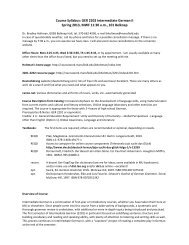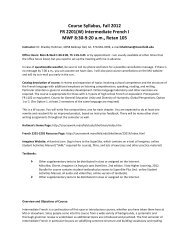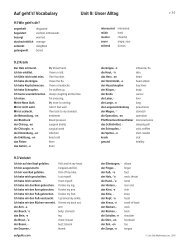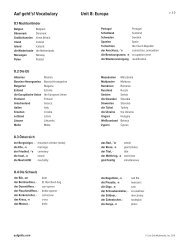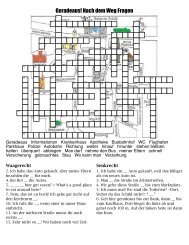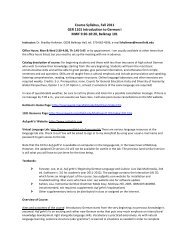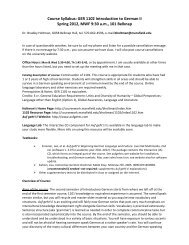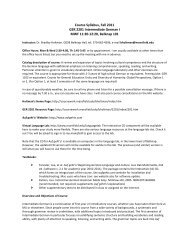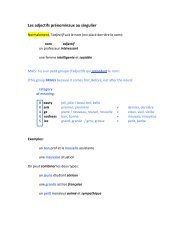Compensation and Job/Work Analysis
Compensation and Job/Work Analysis
Compensation and Job/Work Analysis
Create successful ePaper yourself
Turn your PDF publications into a flip-book with our unique Google optimized e-Paper software.
<strong>Compensation</strong> <strong>and</strong> <strong>Job</strong>/<strong>Work</strong> <strong>Analysis</strong>
Ex. 4.1: Many<br />
Ways to Create<br />
Internal<br />
Structure<br />
(Milkovich, Newman, &<br />
Gerhart, 2011, p. 95)
Ex. 4.3: Determining the Internal <strong>Job</strong> Structure<br />
Internal<br />
relationships in<br />
organization<br />
<strong>Work</strong> analysis<br />
<strong>Job</strong><br />
descriptions<br />
<strong>Job</strong> evaluation<br />
<strong>Job</strong> structure<br />
Collect<br />
information<br />
about the<br />
nature of<br />
specific jobs<br />
(Adapted from Milkovich, Newman, & Gerhart, 2011, p. 97)
<strong>Work</strong> <strong>Analysis</strong><br />
The systematic process of collecting<br />
information that identifies similarities<br />
<strong>and</strong> differences in the work.<br />
(adapted from Milkovich, Newman, & Gerhart, 2011)
Why Perform <strong>Work</strong> <strong>Analysis</strong><br />
• Potential uses exist for every major human<br />
resource function<br />
• An internal structure provides a work-related<br />
rationale for pay differences<br />
• Uses of work analysis in compensation<br />
– Establishes similarities <strong>and</strong> differences<br />
in work content of jobs<br />
– Helps establish an internally<br />
fair <strong>and</strong> aligned job structure
Methods of Data Collection (Psy 3315)<br />
Observation<br />
Interviews (individual or group)<br />
Questionnaires<br />
Diaries<br />
Equipment<br />
Review of existing records/literature<br />
Study of equipment design specifications<br />
Do the work yourself
Generic Categories of Information Collected<br />
(Psy 3315)<br />
<strong>Job</strong> Content<br />
<strong>Job</strong> KSAOs or<br />
Competencies<br />
<strong>Job</strong> Context<br />
Duties, tasks, activities<br />
Knowledge, skills, abilities <strong>and</strong><br />
other characteristics (KSAOs)<br />
Purpose, accountability,<br />
responsibility, supervision<br />
received or given, consequences<br />
of error, physical dem<strong>and</strong>s,<br />
working conditions, shifts,<br />
equipment, etc.<br />
(Bemis, Belenky, & Soder, 1983)
<strong>Work</strong> <strong>Analysis</strong>: Levels of Descriptors<br />
(Brannick, Levine, & Morgeson, 2007, p. 13)
Conventional <strong>Work</strong> <strong>Analysis</strong> Techniques<br />
• Task Inventory <strong>Analysis</strong><br />
• Critical Incident Technique<br />
• Position <strong>Analysis</strong> Questionnaire (PAQ)<br />
• Functional <strong>Job</strong> <strong>Analysis</strong> (FJA)<br />
• Methods <strong>Analysis</strong> (Motion Study)<br />
• Guidelines-Oriented <strong>Job</strong> <strong>Analysis</strong><br />
• Management Position Description Questionnaire<br />
(MPDQ)<br />
• And many more!
Ex. 4.6:<br />
Typical<br />
Data<br />
Collected<br />
for <strong>Work</strong><br />
<strong>Analysis</strong><br />
(Milkovich, Newman, & Gerhart, 2011, p. 101)
The Judgment Call<br />
“How much detail is needed to make pay decisions”
Typical Sources (Psy 3315)<br />
<strong>Work</strong> analyst him/herself<br />
Subject matter experts (SMEs)<br />
• job incumbent(s)<br />
• immediate supervisor(s)<br />
• others who have previously performed job<br />
Technical expert (e.g., prof in field)<br />
Trainers<br />
Clients or customers<br />
Textbooks
Judging <strong>Work</strong> <strong>Analysis</strong><br />
Reliability<br />
Validity<br />
Acceptability<br />
Usefulness/<br />
Practicality<br />
(Milkovich & Newman, 2008)
<strong>Job</strong> Descriptions<br />
<strong>Job</strong> Description<br />
1. <strong>Job</strong> Title.<br />
2. <strong>Job</strong> Identification.<br />
3. Essential Functions.<br />
1. XXX<br />
2. XXX<br />
3. XXX<br />
4. XXX<br />
4. <strong>Job</strong> Specifications.<br />
1. XXX<br />
2. XXX<br />
3. XXX<br />
4. XXX
<strong>Job</strong> Description Categories (Psy 3315)<br />
I. JOB IDENTIFICATION<br />
II. PURPOSE OF JOB/PLACE IN ORGANIZATION<br />
III. JOB SUMMARY<br />
IV. ESSENTIAL FUNCTIONS<br />
V. JOB DUTIES & RESPONSIBILITIES<br />
VI. ACCOUNTABILITIES/EMPLOYMENT STANDARDS<br />
VII. JOB SPECIFICATIONS<br />
VIII. WORKING CONDITIONS/HAZARDS/HOURS<br />
IX. PRODUCTS/TOOLS/EQUIPMENT USED<br />
X. EXTERNAL & INTERNAL CONTACTS<br />
(Carrell, Elbert, & Hatfield, 1995; Gael, 1988)
Exhibit 4.14: <strong>Job</strong> Description for Nurse 100 Years Ago
Exhibit 4.2:<br />
Contemporary<br />
<strong>Job</strong><br />
Description for<br />
Registered<br />
Nurse
Times for Reviewing <strong>Job</strong>s <strong>and</strong> Revising Descriptions<br />
• Assigning a new incumbent to a job<br />
• When major changes are made in product or<br />
outputs provided by work unit or individual<br />
• Introduction of new equipment,<br />
methods, or procedures to workplace<br />
• Reorganization of work unit<br />
• Implementation of a new pay system<br />
• When a new responsibility (a major work activity<br />
area) is added to job



